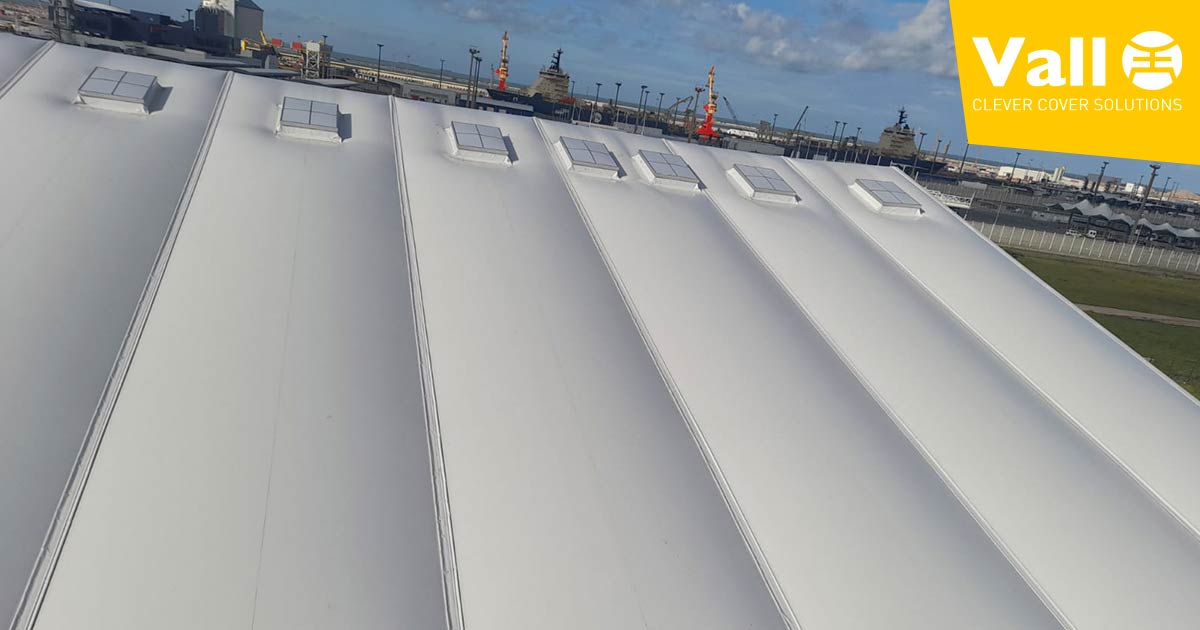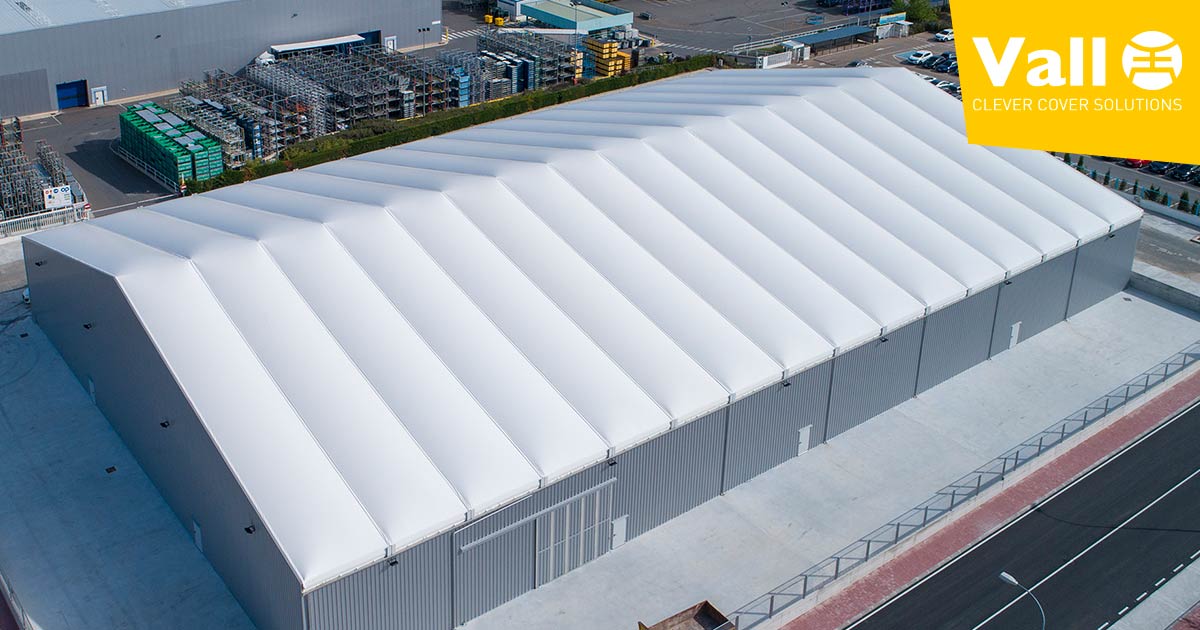The advantages of prefabricated buildings with TWS covers are so relevant and evident that this system is increasingly chosen for new assemblies. In sectors as diverse as industry, commerce, sports pavilions, logistics centres, aircraft hangars, buildings for large events, and others, it provides key benefits for its selection.
At VALL, we offer the possibility to install TWS roofing on our prefabricated metal structure buildings MaxiSpace, SteelSpace and AluSpace.
If you are considering which roofing to choose for your prefabricated building discover the advantages of the Thermo Wind Safe (TWS) system to assess if it is suitable for your project.
Table of contents
What is the Thermo Wind Safe TWS roofing system for prefabricated buildings?
It’s a type of roofing for prefabricated metal structure buildings consisting of a double membrane pressurised tarp system. It includes two layers of PVC tarp with UV filter for high durability. These two tarps are separated by a pressurised air chamber.
To maintain stable pressure, it features a small, low-consumption turbine. This turbine only activates when the pressure drops, which is less than five times a day, thus its consumption is extremely reduced.
In this simple and cost-effective manner, it maintains the air chamber which is largely responsible for the main advantages of the TWS roofing system.

Most notable advantages of prefabricated buildings with TWS roofing.
These advantages stand out at different levels, mainly in terms of safety, monetary savings, and comfort.
Excellent thermal insulation and magnificent energy efficiency: sustainability and savings.
The thermal insulation provided by the TWS roofing is excellent. According to studies, it is nearly 4 times superior to that of a simple tarpaulin, achieving a factor of 1.5 K. For context, the roofs made of sandwich panel of sheet metal and injected polyurethane have a very similar factor, 1 K.
This insulation reduces the energy consumption requirements to maintain a comfortable indoor temperature all year. Its energy efficiency contributes to reducing the carbon footprint of businesses. In sectors such as logistics, the commitment to sustainability is clear and visible in movements like eco-logistics.
This excellent energy efficiency also allows for significant economic savings.
Savings and profitability.
One of the primary advantages of prefabricated buildings with TWS roofing is the savings they enable throughout their entire lifespan. Their quick profitability makes it an increasingly popular choice not only for prefabricated buildings for companies across various sectors but also for institutions and local or regional governments for uses such as sports centres or multipurpose pavilions.
This is due to the high durability of its tarpaulins which can remain like new for decades without maintenance. And combined with the savings on energy supplies provided by its excellent energy efficiency, it becomes profitable very quickly.
Additionally, choosing a type of translucent tarpaulin also saves on lighting during the day.
Stability, resistance, and safety even in areas of strong wind loads.
In terms of stability, resistance, and safety, the advantages of the TWS roofing are very significant. And they are especially important in locations where the wind loads are very strong or can become so. Even in exposed coastal areas or high mountains, where prefabricated buildings with TWS roofing can be installations for ski resorts or mountain stations.
This is because the air chamber located between the tarpaulins cushions the movements that the roof usually suffers from the wind. This cushioning prevents fluttering, increasing its stability.
Another reason that this system improves stability is because the pressurised roof exerts traction on the structure, compacting it. And thus it remains immovable against strong winds, with no perceptible movement or vibration inside due to this reason.
Moreover, in areas where the accumulation of snow or water is high, the roofs with TWS system also enhance safety. The main reason is its rigid finish design that prevents the accumulation of these loads on the roof.

Two tarpaulin options with different advantages.
The tarpaulin of the TWS roofing can be of two types: opaque or translucent. Each one provides different advantages to the prefabricated buildings that have this type of roof. Depending on the user’s needs, one or the other may be more suitable.
- Translucent tarpaulins allow a greater passage of natural light, providing pleasant, diffused, and shadow-free lighting. In terms of comfort, it’s a great advantage. And it also offers greater safety inside due to better visibility during the day.
- Opaque tarpaulins are ideal for a cooler interior in summer with lower energy consumption in areas of hot climate.
A quieter interior thanks to insulation from external noise.
For uses where a quiet interior is valued, choosing prefabricated buildings with TWS roofing is beneficial. Unlike conventional tarpaulin roofs, there’s no noise from fluttering due to wind. And thanks to its air chamber, it provides excellent sound insulation.
A healthier and more comfortable interior space thanks to the tightness of prefabricated buildings with TWS roofing.
Its tightness prevents water condensation. Thus, there’s no sensation of interior humidity. This makes the space more comfortable and also healthier. Its conditions are safer and more comfortable for its users and for the workforce inside.

References:
https://vallchannel.com/presentaciones/cubiertas-lona-sistema-tws/








